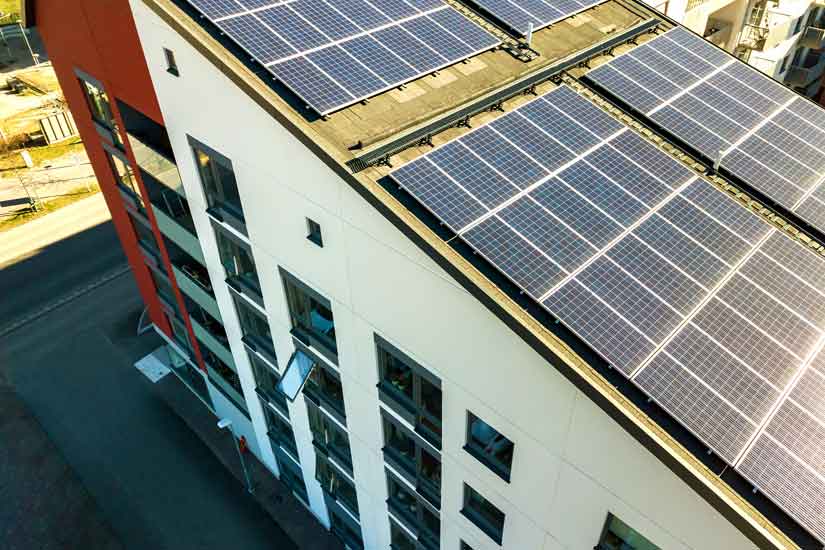JISEA Sustainable Communities Catalyzer Advances Equitable Renewables Deployment
March 4, 2022—Renewable energy development can bolster local economies through job creation, tax revenues, and lower energy costs, but communities that need these benefits the most often see less deployment.
JISEA, in partnership with the National Renewable Energy Laboratory (NREL), intersected data on disadvantaged community indicators and renewable energy generation potential to identify where deployment could have the biggest local impact. The findings are published in a Renewable Energy Focus article.
This work is part of JISEA's Sustainable Communities Catalyzer that is helping to identify pathways for sustainable clean energy transitions, with a focus on rural and disadvantaged communities.

U.S. counties that are closer to traffic or higher concentrations of diesel pollution tend to have greater opportunity for residential rooftop solar. Photo courtesy of iStock
Importance of Environmental Justice and Energy Equity
Environmental hazards like air and water pollution are often concentrated in low-income communities with high minority populations and histories of disinvestment, also known as frontline communities. Although renewable energy deployment does not directly remediate these hazards, it can support economic development and job creation where it is needed most.
Frontline and disadvantaged communities also face more barriers to accessing the benefits of distributed energy resources like rooftop solar or energy storage. Therefore, adoption has largely been concentrated in wealthier, more educated, primarily white neighborhoods.
Households with higher energy burdens—meaning they spend more of their income on energy bills compared to the average household—can't take advantage of clean energy tax credits. Plus, they tend to experience more adverse health effects from living in outdated buildings or polluted urban areas.
Not extending clean energy to disadvantaged communities leaves out a large part of the population. Forty-three percent of the U.S. population classifies as low-income, and their households total 42% of U.S. residential rooftop solar technical potential.
In response to the major gap in deployment, the Biden administration's Justice40 initiative aims to "deliver 40% of the overall benefits of climate investments to disadvantaged communities and inform equitable research, development, and deployment."
"The new JISEA/NREL data can help federal and state decision makers prioritize disadvantaged and environmental justice communities in clean energy infrastructure and program investment decisions," said Megan Day, JISEA/NREL analyst and lead of the Sustainable Communities Catalyzer.
Trends Across Communities and Renewable Energy Potential
Using a suite of models, JISEA/NREL created a new data set that intersects energy burden, environmental hazard, and sociodemographic data with county-level technical generation potential and levelized cost of energy for multiple renewable energy technologies.
"Individual communities can use the new data set to better understand their renewable energy deployment opportunities and inform strategic economic development and energy planning," said Liz Ross, JISEA/NREL analyst who supports the Sustainable Communities Catalyzer.
JISEA/NREL found counties with mining, quarrying, and oil and gas extraction tend to have greater opportunity for wind energy. Counties with larger populations of minorities tend to have relatively lower-cost opportunity for commercial and residential rooftop solar, whereas counties with more individuals who have less than a high school education tend to have relatively lower-cost opportunity for utility-scale solar.
Counties that are closer to traffic or higher concentrations of diesel pollution tend to have greater opportunity for commercial and residential rooftop solar. Counties with higher ozone concentrations tend to have higher opportunity for utility-scale solar and land-based wind, in addition to having relatively lower-cost commercial and residential solar opportunities. Finally, counties with higher respiratory hazard from air toxics tend to have relatively lower-cost geothermal opportunities.
"We risk exacerbating existing inequalities if we fail to prioritize energy justice and expand access to the benefits of renewable energies to disadvantaged communities," Day said. "Our analysis and resulting data set can help prioritize equitable investments."
Access the data set and view a presentation on the intersections of disadvantaged communities and renewable energy potential. Learn more about the JISEA Catalyzers.
Back to JISEA News >
